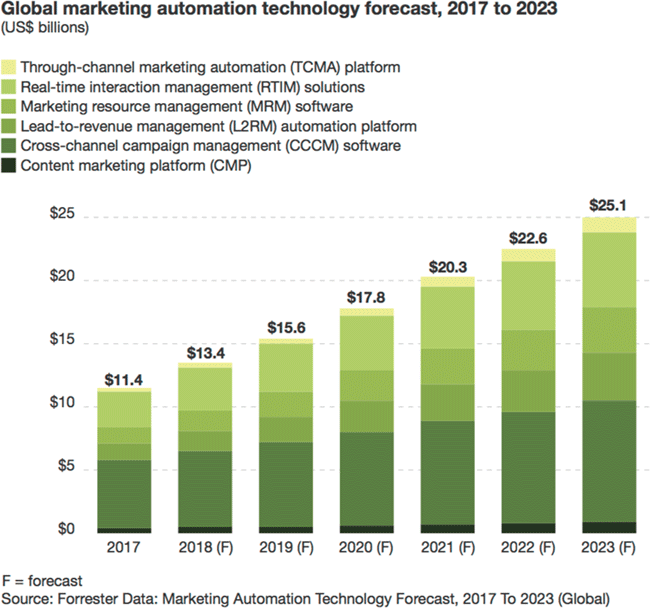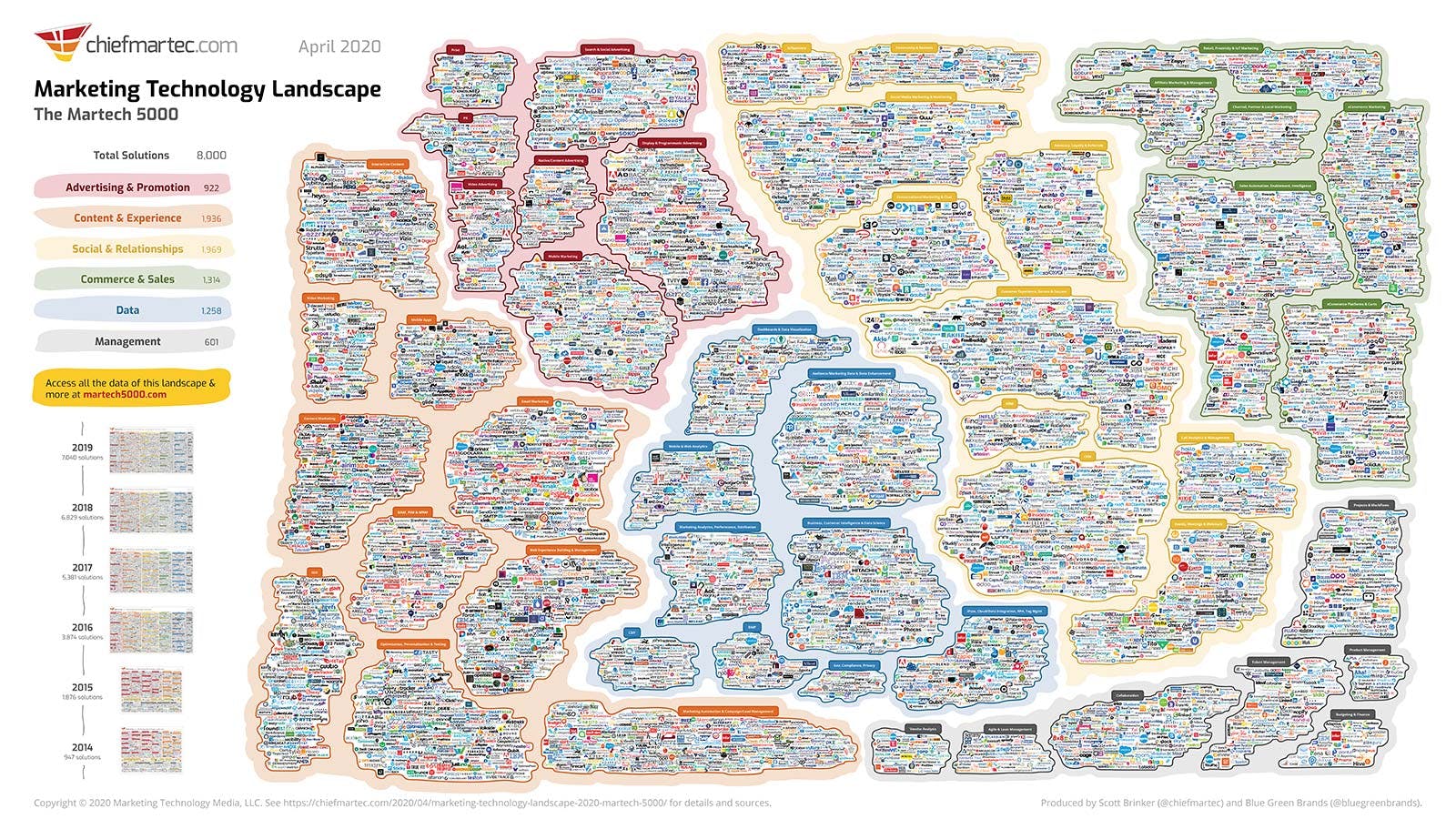Marketing is one of the most dynamic professional areas, as its strategies, approaches and professional routines are constantly being revised. In recent years, marketing automation (MA) has gained a lot of relevance in the industry. However, automating processes is not always the right answer, especially when automation is expected to solve everything without supporting it with an efficient marketing data strategy. We reflect on the role of marketing automation.

The challenges facing marketers are constantly evolving and the latest marketing trends are not far behind. In a context monopolised by data, marketing data and marketing intelligence are already positioned as essential elements of today's marketing. In this sense, marketing automation, one of the most widespread digital marketing trends, is already part of most organisations' business routines.
According to the latest marketing automation research published by Forrester (2017), global investment in marketing automation will continue to increase every year until 2023.

More and more companies are becoming interested in incorporating marketing automation as a member of the marketing team since marketing automation can be very useful when it comes to optimising customer-centric marketing strategies.
However, many marketers make the mistake of thinking that marketing automation will solve their productivity problems, translate into better results or increase their efficiency. Unfortunately, in practice, this does not happen if automation is not accompanied by a comprehensive customer-centric marketing strategy that incorporates leveraging data and technology as part of its identity.
What is marketing automation?
Marketing automation is the automation of one or more marketing tasks through software, technologies or automation tools. This practice involves both operational and strategic tasks.
Process automation is not new to the business world. However, although it has been applied for a long time in certain operational areas, its implementation in marketing is more recent.
On the operational side, in addition to reducing the time spent on unproductive or time-consuming tasks and cutting down the marketing team's workload, marketing automation also helps professionals to take greater control of automated tasks and expands the possibilities for tracking processes and monitoring results.
Because most marketing tasks and processes are nowadays related to the processing of large amounts of customer data, marketing tasks can become very time-consuming. In this sense, marketing automation allows the team to put aside the more tedious tasks related to the processing of marketing data to focus on more productive tasks such as strategy optimisation, campaign design, content creation and so on. Marketing automation also shortens the amount of time the marketing team must spend analysing data to determine which offer, content or experience best serves their customers.
On the other hand, marketing automation also embodies actions that can be linked to more strategic matters related, for example, to an essential process in any marketing data strategy: customer segmentation. Marketing automation can be used to determine the best message to send to a particular customer segment or to identify the behaviour of a target or growing segment.
In this sense, marketing automation is linked to the development of customer-centric strategies and the identification of valuable insights.
Marketing automation tools
Fortunately for marketers, the market is full of martech technologies. Today, marketers have more technologies available to them than they can imagine and certainly ever need. These technologies are intended to help marketers capture, process and analyse customer data to optimise sales processes, increase conversion, generate impact, improve customer understanding and develop customer-centric strategies such as customer segmentation, customer engagement, or customer experience optimisation.
The options are endless. The latest report (2020) from Martech 5000 proves it:

Although there is an extremely wide range of specialised marketing technology on offer, if companies want to progress and improve their results, they must understand that for the implementation of one of these technologies to produce the desired results, it is essential that the tool is accompanied by a comprehensive, customer-centric and data-driven strategic and action plan.
How to apply marketing automation?
As we have already mentioned, marketing automation is not a magic wand and, in fact, it only does one thing: to streamline tasks and reduce the amount of work. In this regard, some corporations make the mistake of entrusting the success of their activity to technology. In practice, however, the success of martech has much more to do with customer-centric strategies than with the technological tools themselves.
So how should we apply marketing automation?
5 important tips on how to apply marketing automation
1. Developing an efficient marketing data and customer intelligence strategy
Marketing automation tools streamline the tasks associated with consumer data. Before starting to work with data (data-driven marketing), it is essential to be clear about the objectives we want to achieve and the purpose of the data we collect and process (smart data). At the end of the day, data is information and if we limit ourselves to collecting information without a well-defined strategy, data and marketing automation will not fulfil their purpose.
It is essential to develop a customer intelligence plan that helps us to define what data is relevant to the achievement of our customer-centric objectives. "What do we want to achieve and how are we going to do it?" are essential questions to answer before we start processing marketing data, just as we must be fully aware of the buying process and the customer experience.
So the first step in applying marketing automation is to establish a clear connection between our marketing data objectives and the customer data and marketing automation platforms we have chosen.
2. Focus on relevant metrics
In relation to the previous point, once we are clear about our marketing data objectives, we need to establish the right metrics to monitor the performance of our marketing processes and operations. If we have defined a proper strategic plan and aligned our business objectives with our marketing data objectives, our metrics will be the right ones.
Choosing relevant metrics and performance indicators according to our objectives is essential if we want to generate impact within the organisation. In terms of defining metrics, it is important not to look only at indicators strictly linked to business performance, but also to explore metrics that provide us with information about the relationship we are creating with our customers and their level of satisfaction. Metrics such as customer lifetime value can help us to identify very significant insights when it comes to improving our conversion rates.
3. Listen to the voice of the costumer.
In marketing, organisations need to think of the voice of the costumer as the fuel that enables them to drive marketing data actions. At the end of the day, the data we capture in our marketing data plan tells us about our customers: their behaviours, needs, wants, desires and so on. Active listening to the voice of our customers should be present throughout the company, not just in the marketing department.
One of the most efficient practices for active listening to the voice of the customer is to pay attention to the customer lifecycle and the customer journey. Both provide us with exhaustive knowledge about the customer's relationship with the products and services we offer and with the different stages of the conversion funnel they must go through until they make a purchase. Implementing this process will help us to draw conclusions about our value proposition, our strengths and our areas for improvement.
Voice of the customer is linked to marketing automation to the extent that, in addition to placing the customer at the centre of the organisation, it helps companies to optimise their segmentation processes, to pinpoint priority segments and to understand the customer journey.
4. Don't underestimate the value of an insight
The purpose of any marketing data, martech or marketing automation strategy is to transform data into insights —in this case, customer insights—- that allow us to identify our customers' pain points, help us make better decisions, improve the customer experience, optimise our marketing campaigns, and so on.
An insight is a high-value discovery found through data analysis and market research that allows deciphering something that is happening, the reasons why and how it can be solved, restored or improved. In this sense, focusing on the identification of insights promotes the development of more strategic tasks, through not only descriptive but also predictive analysis. It also helps marketers to better understand how their customers behave.
Companies that focus on identifying and managing insights will be better able to address customer issues, solve problems, develop insightful content and make improvements where necessary.
5. Invest in martech
Once we have developed our strategic marketing data plan focusing on all of the above, we can move on to the implementation of technologies and software to help us process the data, such as marketing automation tools.
As we have already seen, there are a huge number of marketing-focused technology options available on the market today. However, choosing the right tool is not an easy task.
In line with everything mentioned in this article, when choosing a martech tool or technology it is crucial not to only consider the technical aspects of the tool or technology. We must choose tools that are aligned with our data marketing plan and that respond to the marketing and customer objectives we have set.
Only after we are clear about who our buyer personas are, what our value proposition is and what our positioning strategy is, will we be in a position to decide which tools are best suited to help us transform data into value.
In short
CMOs are now living in an exciting time where the possibilities are endless and the boundaries are becoming increasingly blurred. The challenge, however, is not small. Increasingly reliant on data, marketers must focus on developing marketing data strategies that are more customer-centric than technology-centric, and leverage available tools (such as marketing automation) to stimulate the dynamism and potential of workflows, not drive processes.



